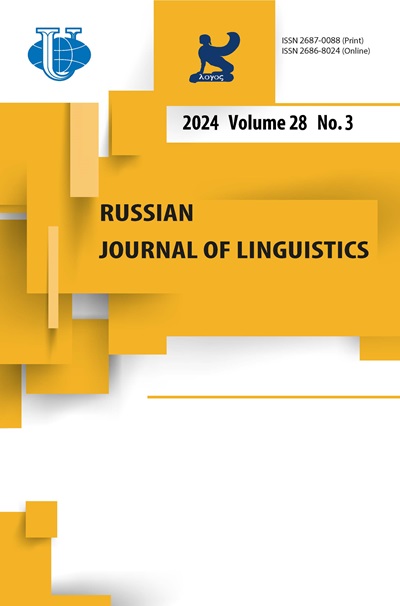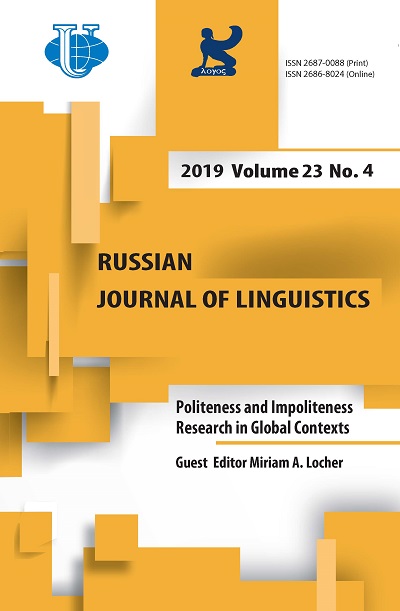Индексальные и последовательные свойства критических замечаний в начале коммуникации: подходы к изучению (не)вежливости в кросс-культурном аспекте
- Авторы: Хо М.1, Чанг В.М.1
-
Учреждения:
- Университет Квинсленда
- Выпуск: Том 23, № 4 (2019): Исследование вежливости и невежливости в глобальном контексте
- Страницы: 904-929
- Раздел: Статьи
- URL: https://journals.rudn.ru/linguistics/article/view/22524
- DOI: https://doi.org/10.22363/2687-0088-2019-23-4-904-929
Цитировать
Полный текст
Аннотация
Кросс-культурные исследования вежливости и невежливости обычно нацелены на выявление различий в вербальном поведении, проявляющихся в реализации отдельных речевых актов, которые затем объясняются основными культурными различиями. В этой статье показано, что данный подход излишне опирается на эмический взгляд на (не)вежливость, т.е на ее понимание носителями данной культуры. Посредством сравнительного анализа критики в начальной фазе общения тайваньских носителей китайского языка и австралийских носителей английского языка мы обращаем внимание на то, как сходства в способах выражения критики и ответов на нее (то есть их последовательные свойства) могут скрывать различия в релевантных для культуры значениях критики (то есть различия их индексальных свойств) в соответствующих языках. Мы пришли к выводу, что межкультурные исследования (не)вежливости должны не только выявлять различия в формах и стратегиях, с помощью которых реализуются речевые акты, но и учитывать то, что якобы одни и те же речевые акты на самом деле могут быть по-разному истолкованы членами различных культурных групп.
Об авторах
Майкл Хо
Университет Квинсленда
Email: michael.haugh@uq.edu.au
профессор лингвистики, преподает в Школе языков и культур Университета Квинсленда Gordon Greenwood Building, Union Road, St Lucia, QLD 4072, Australia
Вей-Лин Мелоди Чанг
Университет Квинсленда
Email: melody.chang@uq.edu.au
преподает китайский язык в Школе языков и культур Университета Квинсленда Gordon Greenwood Building, Union Road, St Lucia, QLD 4072, Australia
Список литературы
- Asmuß, Birte (2008). Performance appraisal interviews. Preference organisation in assessment sequences. Journal of Business Communication, 45(4), 408-429.
- Bolden, Galina & Jeffrey Robinson (2011). Soliciting accounts with why-interrogatives in conversation. Journal of Communication, 61 (1), 94-119.
- Bousfield, Derek (2008). Impoliteness in Interaction. Amsterdam: John Benjamins.
- Brown, Penelope, & Stephen Levinson (1978). Universals in language usage: politeness phenomena. In E. Goody (ed.), Questions and Politeness (pp. 56-311). Cambridge: Cambridge University Press.
- Brown, Penelope, & Stephen Levinson (1987). Politeness. Some Universals in Language Usage. Cambridge: Cambridge University Press.
- Carbaugh, Donal (2005). Cultures in Conversation. London: Routledge.
- Chang, Wei-Lin Melody (forthcoming). “It’s tiring to be your son”: Criticisms in Taiwanese Chinese initial interactions. Journal of Pragmatics.
- Copland, F. (2011). Negotiating face in feedback conferences: a linguistic ethnographic analysis. Journal of Pragmatics, 43 (5), 3832-3843.
- Couper-Kuhlen, Elizabeth & Margaret Selting (2018). Interactional Linguistics. Cambridge: Cambridge University Press.
- Culpeper, Jonathan (2011). Impoliteness: Using Language to Cause Offence. Cambridge: Cambridge University Press.
- Culpeper, Jonathan (2015). Impoliteness strategies. In A. Capone & J. Mey (eds.), Interdisciplinary Studies in Pragmatics, Culture and Society (pp. 421-445). New York: Springer.
- D’Amico-Reisner, Lynne (1983). An analysis of the surface structure of disapproval exchanges. In N. Wolfson & E. Judd (eds.), Sociolinguistics and Language Acquisition (pp. 103-115). Rowley, MA: Newbury House.
- Dayter, Daria & Sofia Rüdiger (2018). In other words: ‘The language of attraction’ used by pick-up artists. English Today, 35 (2), 13-19.
- Edwards, Derek & Jonathan Potter (2017). Some uses of subject-side assessments. Discourse Studies, 19 (5), 497-514.
- Eelen, Gino (2001). A Critique of Politeness Theories. Manchester: St. Jerome.
- Endo, Tomoko (2013). Epistemic stance in Mandarin conversation: The positions and functions of wo juede (I feel/think). In Y. Pan & D. Kádár (ed.), Chinese Discourse and Interaction: Theory and Practice (pp. 12-34). London: Equinox.
- Flint, Natalie, Michael Haugh & Andrew John Merrison (2019). Modulating troubles affiliating in initial interactions. The role of remedial accounts. Pragmatics, 29 (3), 384-409.
- Garfinkel, Harold (1967). Studies in Ethnomethodology. Englewood Cliffs, NJ: Prentice-Hall.
- Goodwin, Charles & Marjorie Harness Goodwin (1992). Assessments and the construction of context. In A. Duranti & C. Goodwin (eds.), Rethinking Context: Language as an Interactive Phenomenon (pp. 151-189). Cambridge: Cambridge University Press.
- Grainger, Karen (2013). Of babies and bath water: Is there any place for Austin and Grice in interpersonal pragmatics? Journal of Pragmatics, 58, 27-38.
- Hambling-Jones, Oliver & Andrew John Merrison (2012). Inequity in the pursuit of intimacy: An analysis of British pick-up artist interactions. Journal of Pragmatics, 44, 1115-1127.
- Haugh, Michael (2006). Emic perspectives on the positive-negative politeness distinction. Culture, Language and Representation, 3, 17-26.
- Haugh, Michael (2007). The discursive challenge to politeness theory: an interactional alternative. Journal of Politeness Research, 3 (2), 295-317.
- Haugh, Michael (2009). Face and interaction. In F. Bargiela-Chiappini & M. Haugh (Eds.), Face, Communication and Social Interaction (pp. 1-30). London: Equinox.
- Haugh, Michael (2011). Humour, face and im/politeness in getting acquainted. In B. Davies, M. Haugh, & A. Merrison (eds.). Situated Politeness (pp. 165-184). London: Continuum.
- Haugh, Michael (2012). Epilogue: The first-second order distinction in face and politeness research. Journal of Politeness Research, 8 (1), 111-134.
- Haugh, Michael (2015a). Impoliteness and taking offence in initial interactions. Journal of Pragmatics, 86, 36-42.
- Haugh, Michael (2015b). Im/politeness Implicatures. Berlin: Mouton de Gruyter.
- Haugh, Michael (2018). Theorising (im)politeness. Journal of Politeness Research, 14 (1), 153-165.
- Haugh, Michael & Donal Carbaugh (2015). Self-disclosure in initial interactions amongst speakers of American and Australian English. Multilingua, 34 (4), 461-493.
- Haugh, Michael & Chang, Wei-Lin Melody. (2015). Understanding im/politeness across cultures: an interactional approach to raising sociopragmatic awareness. IRAL: International Review of Applied Linguistics, 53 (4), 389-414.
- Haugh, Michael & Simon Musgrave (2019). Conversational lapses and laughter: Towards a combinatorial approach to building collections in conversation analysis. Journal of Pragmatics, 143, 279-291.
- Haugh, Michael & Danielle Pillet-Shore (2018). Getting to know you: Teasing as an invitation to intimacy. Discourse Studies, 20 (2), 246-269.
- Headland, Thomas, Kenneth Pike & Marvin Harris (eds.) (1990). Emics and Etics. The Insider/ Outsider Debate. Newbury Park: Sage.
- Heritage, John (1988). Explanations as accounts: a conversation analytic perspective. In C. Antaki (ed.). Analysing Everyday Explanation: A Casebook of Methods (pp. 127-144). London: Sage.
- Ho, David Yau-fai (1976). On the concept of face. American Journal of Sociology, 81 (4), 867-884.
- House, Juliane & Gabriele Kasper (1981). Politeness makers in English and German. In Florian Coulmas (ed.). Conversational Routines (pp. 157-185). The Hague: de Gruyter.
- Jefferson, Gail (2004). Glossary of transcript symbols with an introduction. In Gene Lerner (ed.). Conversation Analysis: Studies from the First Generation (pp. 13-23). Amsterdam: John Benjamins.
- Kádár, Dániel Z. & Michael Haugh (2013). Understanding Politeness. Cambridge: Cambridge University Press.
- Kinnison, Li Qing (2017). Power, integrity and mask - an attempt to disentangle the Chinese face concept. Journal of Pragmatics, 114, 32-48.
- Lang, Jun (2018). ‘I am not criticizing you’. A constructionist analysis of an indirect speech act. Chinese Language and Discourse, 9 (2), 184-208.
- Leech, Geoffrey (1983). Principles of Pragmatics. London: Longman.
- Li, Sarah, & Clive Seale (2007). Managing criticism in PhD supervision: A qualitative case study. Studies in Higher Education, 32 (4), 511-526.
- Malle, Bertram, Steve Guglielmo & Andrew Monroe (2014). A theory of blame. Psychological Inquiry, 25 (1), 147-186.
- Mills, Sara. (2003). Gender and Politeness. Cambridge: Cambridge University Press.
- Morris, G.H. (1988). Finding fault. Journal of Language and Social Psychology, 7 (1), 1-25.
- Nguyen, Thi Thuy Minh (2008). Criticising in an L2: pragmatic strategies used by Vietnamese EFL learners. Intercultural Pragmatics, 5 (1), 41-66.
- Pillet-Shore, Danielle (2015). Being a “good parent” in parent-teacher conferences. Journal of Communication, 65 (2), 373-395.
- Pillet-Shore, Danielle (2016). Criticizing another's child: How teachers evaluate students during parent-teacher conferences. Language in Society, 45 (1), 33-58.
- Pomerantz, Anita (1984). Agreeing and disagreeing with assessments: some features of preferred/ dispreferred turn shapes. In J. Maxwell Atkinson & John Heritage (eds.), Structures of Social Action : Studies in Conversation Analysis (pp. 57-101). Cambridge: Cambridge University Press.
- Pomerantz, Anita (1986). Extreme case formulations: a way of legitimizing claims. Human Studies, 9, 219-229.
- Robinson, Jeffrey & GalinaB olden (2010). Preference organization of sequence-initiating actions: the case of explicit account solicitations. Discourse Studies, 12 (4), 501-533.
- Sacks, Harvey, Emanuel Schegloff & Gail Jefferson (1974). A simplest systematics for the organisation of turn-taking for conversation. Language, 50, 696-735.
- Sanders, Robert & Kristine Fitch (2001). The actual practice of compliance seeking. Communication Theory, 11 (3), 263-289.
- Schegloff, Emanuel (2007). Sequence Organization in Interaction. Cambridge: Cambridge University Press.
- Schuer, Jann (2014). Managing employees’ talk about problems in work in performance appraisal interviews. Discourse Studies, 16 (3), 407-429.
- Shaw, Chloe, Alexa Hepburn & Jonathan Potter (2013). Having the last laugh: on post-completion laughter particles. In Phillip Glenn & Elizabeth Holt (eds.), Studies of Laughter in Interaction (pp. 91-106). London: Bloomsbury.
- Sifianou, Maria & Pilar Garcés-Conejos Blitvich (2017). (Im)politeness and cultural variation. In Jonathan Culpeper, Michael Haugh, & Dániel Z. Kádár (eds.). The Palgrave Handbook of Linguistic (Im)politeness (pp. 571-599). London: Palgrave Macmillan.
- Spencer-Oatey, Helen & Dániel Z. Kádár (2016). The bases of (im)politeness evaluations: culture, the moral order and the East-West debate. East Asian Pragmatics, 1 (1), 73-106.
- Stivers, Tanya (2008). Stance, alignment, and affiliation during storytelling: when nodding is a token of affiliation. Research on Language and Social Interaction, 41 (1), 31-57.
- Stivers, Tanya & Fredrico Rossano (2010). Mobilising response. Research on Language and Social Interaction, 43 (1), 3-31.
- Svennevig, Jan (1999). Getting Acquainted in Conversation. Amsterdam: John Benjamins.
- Svennevig, Jan (2014). Direct and indirect self-presentation in first conversations. Journal of Language and Social Psychology, 33 (3), 302-327.
- Tayebi, Tamineh (2018). Implying an impolite belief: a case of tikkeh in Persian. Intercultural Pragmatics, 15 (1), 89-113.
- Tracy, Karen & Eric Eisenberg (1990/91). Giving criticism: a multiple goals case study. Research on Language and Social Interaction, 24 (1), 37-70.
- Tracy, Karen, Donna Van Dusen & Susan Robinson (1987). ‘Good’ and ‘bad’ criticism: A descriptive analysis. Journal of Communication, 37 (1), 46-59.
- Tseng, Shu-Chuan (2004). Processing spoken Mandarin corpora. Traitement Automatique des Langues. Special Issue: Spoken Corpus Processing, 45 (2), 89-108.
- Tseng, Shu-Chuan (2008). Spoken corpora and analysis of natural speech. Taiwan Journal of Linguistics, 6 (2), 1-26.
- Vanderveken, Daniel (1990). Meaning and Speech Acts. Cambridge: Cambridge University Press.
- Watts, Richard, Sachiko Ide & Konrad. Ehlich (1992). Introduction. In Richard Watts, Sachiko Ide, & Konrad Ehlich (eds.). Politeness in Language. Studies in its History, Theory and Practice (pp. 1-17). Berlin: Mouton de Gruyter.
- Wierzbicka, Anna (1987). English Speech Act Verbs. A Semantic Dictionary. Sydney: Academic Press.
- Wilkinson, Sue & Celia Kitzinger (2006). Surprise as an interactional achivement: reaction tokens in conversation. Social Psychology Quarterly, 69 (2), 150-182.
- Wu, Ruey-Jiuan (2004). Stance-in-Talk: A Conversation Analysis of Mandarin Final Particles. Amersterdam: John Benjamins

















